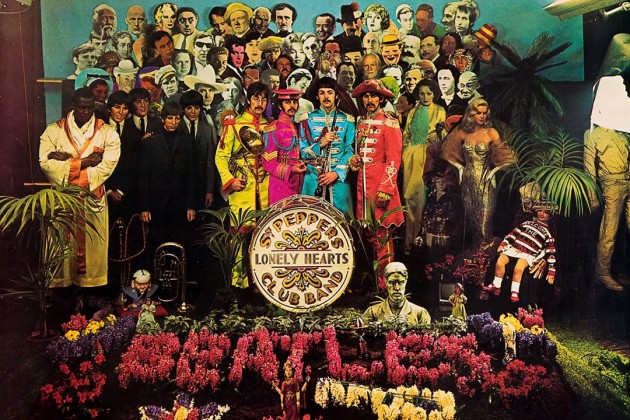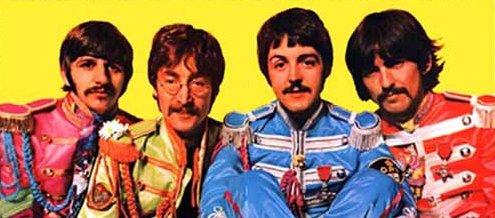How Sgt. Pepper's Lonely Hearts Club Band Blew My Mind.
Written by John Diliberto on June 1, 2017
 Tonight on Echoes, hear Sgt. Pepper’s Lonely Hearts Club Band done in covers, and a hyper-version of “Lucy in the Sky with Diamonds.”
Tonight on Echoes, hear Sgt. Pepper’s Lonely Hearts Club Band done in covers, and a hyper-version of “Lucy in the Sky with Diamonds.”
How many ways did Sgt. Pepper’s Lonely Hearts Club Band blow my mind? 1967 was the year that I really began buying albums. And what a year: The Doors’ debut AND Strange Days, Jimi Hendrix’s Are You Experienced AND Axis: Bold as Love, The Jefferson Airplane’s Surrealistic Pillow AND After Bathing at Baxters, The Velvet Underground and Nico, Pink Floyd’s A Piper at the Gates of Dawn, just keep going.
But right in the middle of the year, released May 26 in England, was the album that tied it all together, The Beatles’ Sgt. Pepper’s Lonely Hearts Club Band . In retrospect, I’m amazed that I had the open ears necessary to experience this album which was often off-the track of even the most adventurous rock at the time. Paul McCartney’s Music Hall affectations should’ve hit my ears as corny, and some of it did, yet within the sound world of Sgt. Pepper’s, it all made sense. It was a sound world set up by the opening title track, which established that this wasn’t the Beatles playing, this was many different bands, a revue from an altered state of mind.
Sgt. Pepper’s is often considered one of the first concept albums, but the concept was really the packaging. The Lonely Hearts Club Band conceit, with the one and only Billy Shears, was the genesis of the album, but the effect was more of a variety show. You could not find a more thematically and musically diverse album, from the circus sounds of “Being for the Benefit of Mr. Kite” to the Indian drone of “Within You Without You” to the sweet balladry of “She’s Leaving Home” to the psychedelia of “Lucy in the Sky with Diamonds.” “A Day in the Life” on its own is a collection of scattered musical fragments. The overarching concept evolved into more of a time-tripping journey, the Beatles inhabiting unique musical modes and ultimately making them their own.
Sgt. Pepper’s defined and defied the psychedelic era to which it is wedded. The title track was one of the most rocking tunes on the album, but it was far from psychedelic, transformed even further by marching band horns in the chorus to something bordering on parody. But it served the function of wiping away the world, wiping away anything else you were listening to. Experiencing the title song, you passed through a door that closed behind you for 39 minutes and 52 seconds.
You just didn’t expect that the first thing you heard when the door closed would be “With a Little Help from my Friends,” featuring Ringo on vocals. I like the charm of it and it contains one of Paul McCartney’s most inventive bass lines, but it was always a track I felt was getting in the way of the crux of the album, “Lucy in the Sky with Diamonds.”
The transition into “Lucy in the Sky with Diamonds” was almost a whiplash effect, as if they were trying to show you just how far gone from reality we were all getting. John Lennon always insisted that the title was not a stand in for LSD, but instead the name of a drawing made by his son, Julian. But that still doesn’t take away from the song as one of the definitive psychedelic tracks ever. Lennon painted a picture of swirling images, decorated by a baroque landscape of harpsichord-like keyboards, tamboura drone, and McCartney’s chugging bassline. The album’s entire psychedelic reputation resides in this song along with “Within You Without You,” “Being for the Benefit of Mr. Kite” and “A Day in the Life”
 George Harrison’s lone contribution, “Within You Without You” tapped the eastern consciousness that was already emerging. This may be one of the two most covered songs on the album, a favorite of musicians with an eastern bent as well as modal jazz improvisers. Patti Smith, Sonic Youth, The Flaming Lips, Dave Liebman, The Tedeschi-Trucks Band, the Angels of Venice and Gary Stroutsos are among those who have followed its eastern trance groove.
George Harrison’s lone contribution, “Within You Without You” tapped the eastern consciousness that was already emerging. This may be one of the two most covered songs on the album, a favorite of musicians with an eastern bent as well as modal jazz improvisers. Patti Smith, Sonic Youth, The Flaming Lips, Dave Liebman, The Tedeschi-Trucks Band, the Angels of Venice and Gary Stroutsos are among those who have followed its eastern trance groove.
The album alternates more lysergic songs with more grounded affairs. “She’s Leaving Home” is McCartney’s follow-up to “Eleanor Rigby.” Only this time, the woman isn’t going to wait, sitting by the window. She’s getting out. And when she escaped for the “fun that money can’t buy,” she was at the circus of “Being for the Benefit of Mr. Kite” whose lyrics Lennon and McCartney took, nearly verbatim, from a circus poster. Their circus, however is closer to “Something Wicked This Way Comes” in tone, with swirling keyboards and tape effects while Lennon sings in a tone that borders on malevolence.
If not for “Good Morning Good Morning”, “Getting Better” and maybe “Lovely Rita” you’d be hard put to call Sgt. Pepper’s a rock album at all. But even on these songs, they drop in some more tamboura drone and sound effects.
The turn from “Within You Without You” to “When I’m 64” has to be one of the most train-wreck transitions of modern music. McCartney’s hymn to old age, with its music hall oom-pah-pah, couldn’t be more incongruous to Harrison’s eastern mantra.
Sgt. Pepper’s ends with an even more rocking rendition of the title track. Yes, I know that “A Day in the Life” is the final track on the album, but the title themes are really the bookends. In comparing Pepper’s to The Rolling Stones’ Their Satanic Majesties Request, the writer Paul Williams said that the Stones didn’t want you to consider their album seriously, which is why they end it with the song “On with the Show”, a musical cousin to “Being for the Benefit of Mr. Kite”. But The Beatles, said Williams, were saying with “Sgt. Pepper’s (Reprise),” don’t take any of it seriously, except for “A Day in the Life.” It’s a surreal tale, partly using the cut-up lyric techniques pioneered by William Burroughs and later used by David Bowie. Each verse was like a dream state where you turn your head and you’re in a different scene. The musical structures were more adventurous and revealed the fragmented song style that McCartney would go on to use as a solo artist.
 Even though it’s assembled from disparate songs, Sgt. Pepper’s Lonely Hearts Club Band remains a trip. Every song is a musical microverse unlike anything you’d heard before, even the music hall songs. And when that massive piano chord ends and the rest of the world seeps into your hearing, you know that you’ve been somewhere new. It’s a psychedelic masterpiece that can still blow your mind 50 years later. Paul McCartney has stated that it was a drug album because they were all under the influence, but for me, a dose of Sgt.Peppers was all I needed. And hearing the newly remixed version, the magic I first heard in 1967 is their with even more sonic intensity.
Even though it’s assembled from disparate songs, Sgt. Pepper’s Lonely Hearts Club Band remains a trip. Every song is a musical microverse unlike anything you’d heard before, even the music hall songs. And when that massive piano chord ends and the rest of the world seeps into your hearing, you know that you’ve been somewhere new. It’s a psychedelic masterpiece that can still blow your mind 50 years later. Paul McCartney has stated that it was a drug album because they were all under the influence, but for me, a dose of Sgt.Peppers was all I needed. And hearing the newly remixed version, the magic I first heard in 1967 is their with even more sonic intensity.
